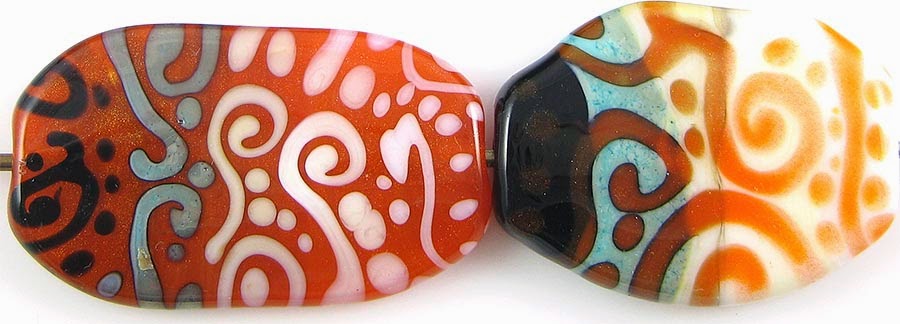1 - Plain (reduced), 2 - Plain, 3 - w/ Silver Leaf, 4 - w/ Silver Leaf (encased), 5 - w/ Silver Glass Frit (reduced), 6 - w/ TerraNova2 Frit, 7 - w/ Silver Glass Frit Stringer (encased), 8 - Over Silver Foil, 9 & 10 - w/ Tuxedo, Copper Green, Opal Yellow, Ivory, and Peace
I was so excited when I first saw
CiM Flax, because I have really been wanting a nice, cool, pale yellow. I was a little less excited when I found that Flax will strike with repeated heating and cooling, but after doing some sculptural work with it I felt happy again because it seems like this is a controllable thing, although I don't yet have many useful words for you about how you might control it.
What I can say for sure is that sometimes it struck to bright yellow on me, and sometimes it did not. In the beads where it did, the common factor is that I pressed them with a cool tool. I am guessing that it is repeated, dramatic heating and cooling that will move it away from its beautiful, pale, champagne colour into a more 'electric yellow' hue range. So, if you want to keep it pale, keep it cool!
As you can see here, unstruck Flax is significantly lighter in colour than Effetre Straw Yellow. It stayed pale in this bead, and between this and the spacers in the group shot, I am able to tell you that this colour is way less prone to strike than its Effetre counterpart, Electric Yellow. I made and garaged this bead pretty quickly, and so the fact that it stayed light may be due to the short duration of its exposure to the flame.
Although this colours strikes to a bright yellow like Effetre Electric Yellow, its reactions with silver and other colours are significantly different. Firstly, while Electric Yellow turns grey when used with silver, Flax seems not to. The silver spread out on top of this colour and developed a bit of a blueish haze, but did not blacken at all. This colour's reactions are more consistent with Straw Yellow's behaviour, but not exactly the same.

While the silver foil in this bead does look sort of golden like it might have colour-changed under the Flax, it could just be that the Flax struck to bright yellow and so it is a reflection rather than a change. This last idea is sort of reinforced by the fact that the whole encasement layer looks a little yellow when you look at the bottom edge of the bead, however a reflection might also make it do that since glass is so light-sensitive. I apologize for the number of words you had to read there to find out I didn't really have much in the way of useful things to say about this test.

Flax seems to be an interesting base for silver glass. There is one fritty bit in the leftmost bead that is particularly interesting looking, with both a black line AND a halo around it. If only I knew what silver glass that piece was, we would really have an interesting discovery. I know for sure that it is either Psyche, Triton, Kronos, Aion, Elektra, or Gaia which narrows it down a little if you feel like experimenting further. Flax was pretty friendly to my striking silver glass as well in the bead in the middle, and I was able to get some pretty blues from the TerraNova2 without much effort investment.
In the rightmost bead, I got an interesting effect by pulling frit stringer with Flax and my silver glass reduction blend. I wrapped the stringer around a Flax core and then encased it with Clear. There are glasses that do this effect better, but way more colours that don't work to get this interesting streakiness at all. In the bead where I did this test with Effetre Electric Yellow, the stringer mostly just turned an icky grey. I would categorize Flax as a pretty silver-friendly colour, overall.
Here the Flax really struck to bright yellow. In the construction of these beads, I make the base, and then I put all of the decoration on. I heat the bead and mash it, and then I heat it gently to firepolish the chill marks out. The steps were the same for both beads.
In terms of interesting reactions, I got a light separation line between Flax and Copper Green on the Copper Green side of the equation in both beads, although the effect looks very different in each. I also got some fairly interesting separation with Opal Yellow which bears further exploration because I think that the yellow-on-yellowness of it has interesting design potential. There was a little separation of Peace as well, but not as significantly.
My Tuxedo seemed to thin out and looks sort of blue where I used it on top of Flax.
Here is a sculptural bead with Flax. It is interesting to note here that the Flax has just barely started to strike in this bead in spite of it being repeatedly and thoroughly heated and cooled during its construction. I am going to attribute this to the fact that I use very few tools in the construction of my goddess beads and that as a result, the bead did not receive the same dramatic quick-heating/cooling cycles as the beads that I used metal tools on did.
































